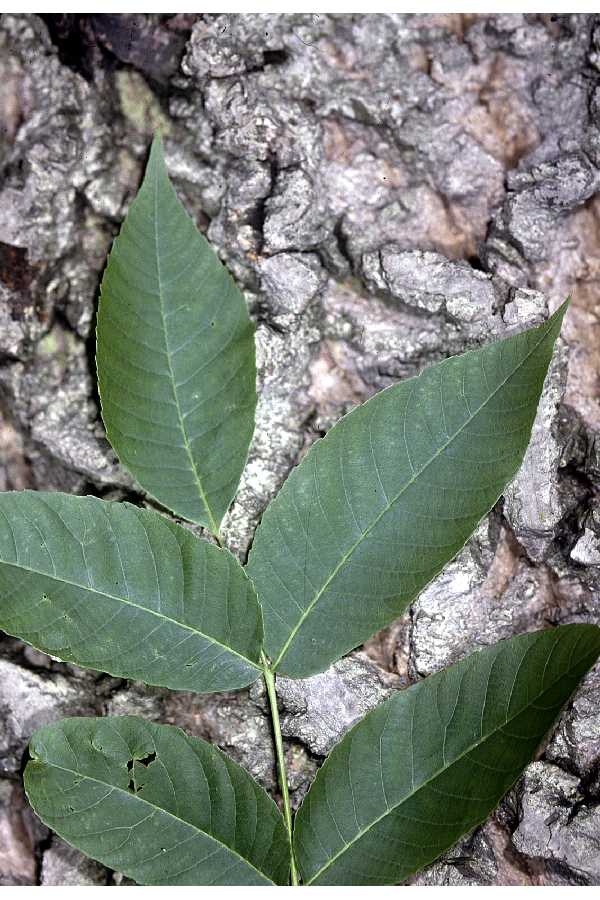butternut
butternut (Juglans cinerea)

Video from the North Carolina Extension Gardener
Conservation Status: Special Concern
Description:
The Butternut is also called white walnut. It is native to the eastern United States. The butternut grows further north than the black walnut. Moreover, the nuts are edible and have a mild flavor.
Butternut trees are commonly found in floodplain benches and rocky slopes. They are partially shade tolerant, needing small openings to reach for sunlight. This species of tree does not tolerate fire. Once exposed to fire, butternut trees do not re-sprout.
Trees live 60 years and begin producing nuts when approximately 30 years old. They grow to 50-60 feet tall.
The Butternut is listed as an species of special concern in the Wisconsin Natural Heritage Inventory, which lists rare species in the state (endangered, threatened and special concern). Its listing is because butternuts commonly suffer from a canker that has greatly reduced their numbers.
butternut
| USDA Symbol: | Common Name: | Scientific Name: |
|---|---|---|
| JUCI | butternut | Juglans cinerea |
ITIS TSN: 19250
Category: Dicot
Taxonomy
Kingdom: Plantae
Subkingdom:
Super Division: Spermatophyta
Division: Magnoliophyta
Subdivision:
Class: Magnoliopsida
SubClass: Hamamelididae
Order: Juglandales
Family: Juglandaceae
Counties: Adams, Barron, Brown, Buffalo, Burnett, Calumet, Chippewa, Clark, Columbia, Crawford, Dane, Door, Douglas, Dunn, Eau Claire, Fond du Lac, Forest, Grant, Green, Iowa, Jefferson, Juneau, La Crosse, Lafayette, Langlade, Lincoln, Manitowoc, Marathon, Marinette, Marquette, Milwaukee, Monroe, Oconto, Oneida, Outagamie, Ozaukee, Pierce, Polk, Price, Racine, Richland, Rock, Rusk, Sauk, Sawyer, Shawano, Sheboygan, Taylor, Trempealeau, Vernon, Walworth, Washburn, Washington, Waukesha, Waupaca, Waushara, Wood
| Duration: | Growth Habit: | Native Status: |
|---|---|---|
| Perennial | Tree | L48(N)CAN(N) |
| NR40 Listed Plant | Noxious Weed: | Invasive Species (NR40): | Threatened/Endangered: | WI Natural Heritage Index: | Wetland Status |
|---|---|---|---|---|---|
| Native | Special concern | FACU |
Active Growth Period: Spring and Summer
Bloat: None
Carbon to Nitrogen Ratio: High
Coppice Potential: Yes
Conspicuous Fall Color: Yes
Fire Resistant: No
Flower Color: Green
Conspicuous Flower: No
Foliage Color: Green
Foliage Light Porosity Summer: Moderate
Foliage Porosity Winter: Porous
Foliage Texture: Coarse
Fruit/Seed Color: Brown
Growth Form: Single Stem
Growth Rate: Rapid
Height at Base Age (Max): 20
Known Alelopath: Yes
Leaf Retention: No
Lifespan: Short
Re-sproutability: Yes
Shape and Orientation: Erect
Toxicity: Slight
Height (min):
Height (max):
Root Type:
Leaf Type:
Leaf Arrangement:
Leaf Shape:
Vein Pattern:
Adapted to Coarse Textured Soils: Yes
Adapted to Medium Textured Soils: Yes
Adapted to Fine Textured Soils: No
CaCO3 Tolerance: None
Cold Stratification Required: Yes
Drought Tolerance: Low
Fertility Requirement: Medium
_Fire Tolerance: Low
Hedge Tolerance: Low
Moisture Use: Medium
pH (Minimum): 6
pH (Maximum): 7
Planting Density per Acre, Minimum: 100
Planting Density per Acre, Maximum: 800
Precipitation (Minimum): 25
Precipitation (Maximum): 80
Root Depth, Minimum (inches): 40
Salinity Tolerance: None
Shade Tolerance: Intolerant
Temperature, Minimum (°F): -33
Plant Spacing (min):
Plant Spacing (max):
| Bloom Period: | Commercial Availability: | Fruit/Seed Abundance: |
|---|---|---|
| Late Spring | Routinely Available | Medium |
| Fruit/Seed Period Begin: | Fruit/Seed Period End: | Fruit/Seed Persistence: |
|---|---|---|
| Fall | Winter | Yes |
| Propogated by Bare Root: | Propogated by Bulbs: | Propogated by Container: |
|---|---|---|
| Yes | No | Yes |
| Propogated by Corms: | Propogated by Cuttings: | Propogated by Seed: |
|---|---|---|
| No | No | Yes |
| Propogated by Sod: | Propogated by Sprigs: | Propogated by Tubers: |
|---|---|---|
| No | No | No |
| Seeds per Pound: | Seed Spread Rate: | Seedling Vigor: |
|---|---|---|
| 30 | Slow | High |
| Small Grain: | Vegetative Spread Rate: | Propagation Treatment: |
|---|---|---|
| No | None |
| Days to Stratify: | Direct Sowing Time: |
|---|---|
Benefits:
| Berry/Nut/Seed Product: | Christmas Tree Product: | Fodder Product: |
|---|---|---|
| Yes | No | No |
| Fuelwood Product: | Lumber Product: | Naval Store Product: |
|---|---|---|
| High | Yes | No |
| Nursery Stock Product: | Palatable Browse Animal: | Palatable Graze Animal: |
|---|---|---|
| Yes | Low | Low |
| Palatable Human: | Post Product: | Protein Potential: |
|---|---|---|
| Yes | Yes | -- |
| Pulpwood Product: | Veneer Product: |
|---|---|
| Yes | Yes |
| Benefits: | Wildlife Food Value: | Wildlife Cover Value: |
|---|---|---|
